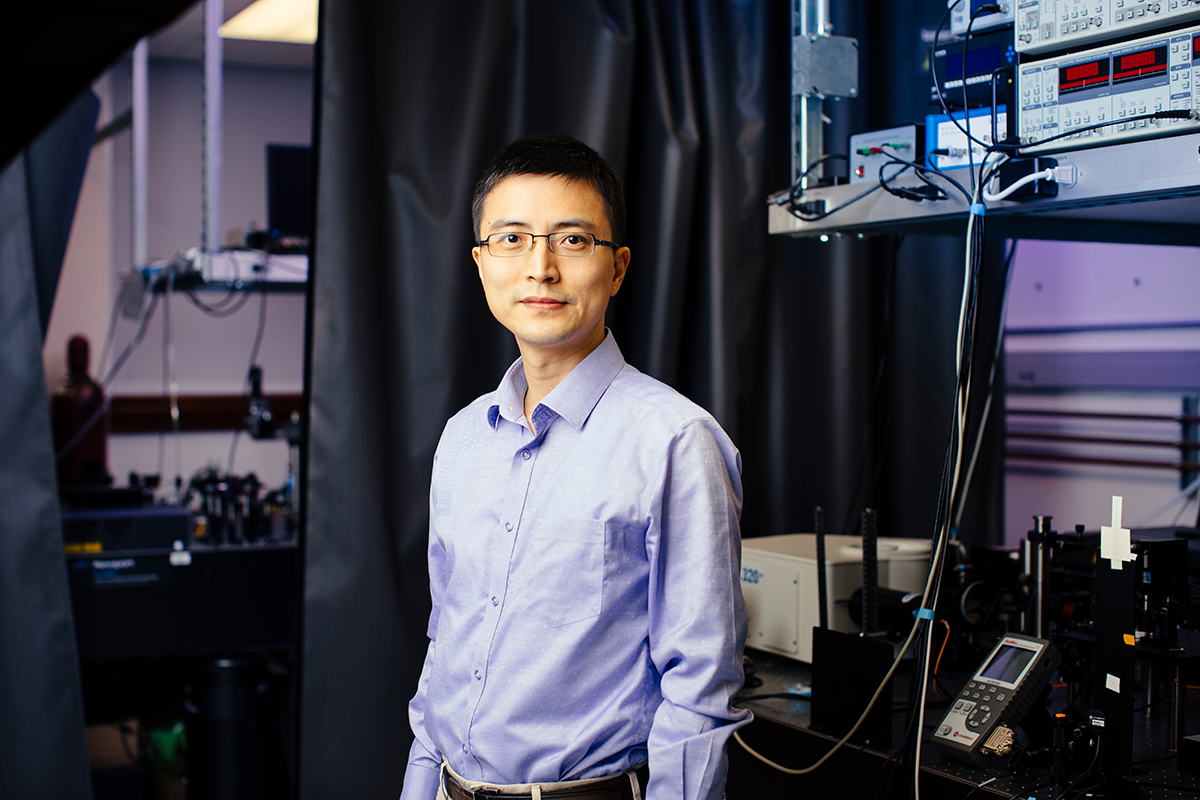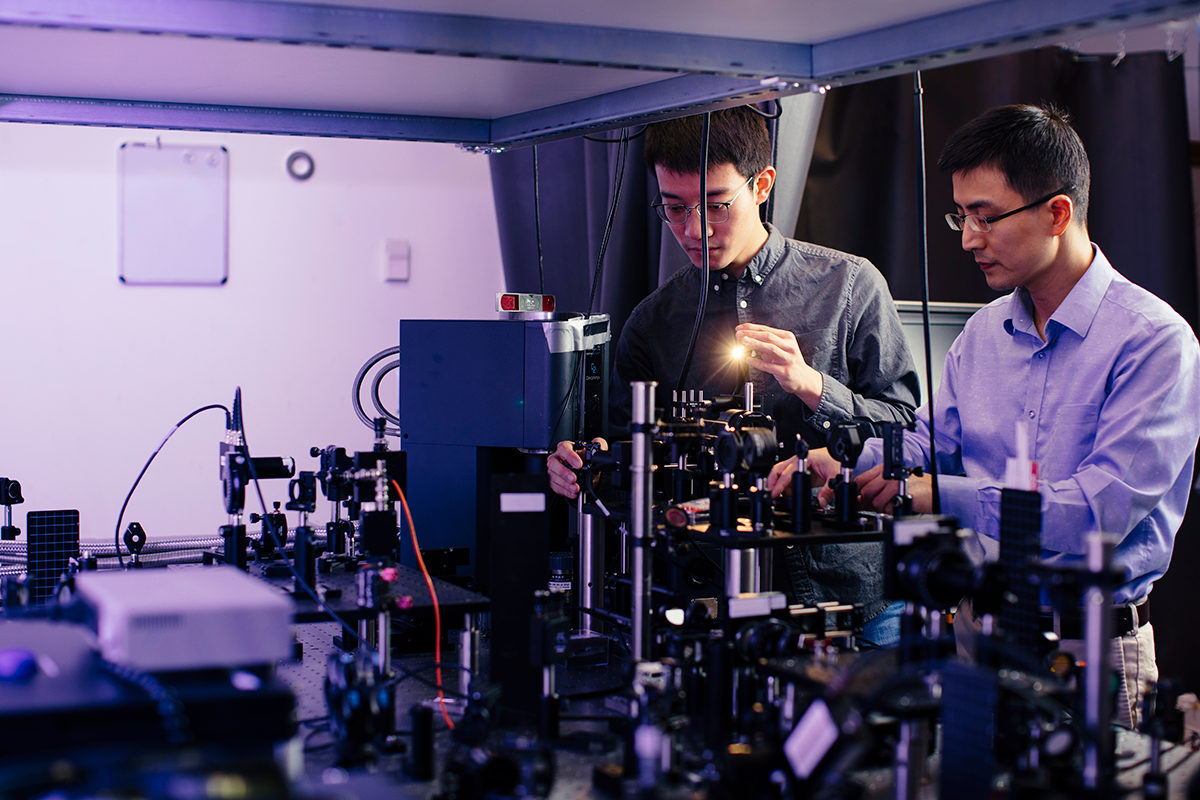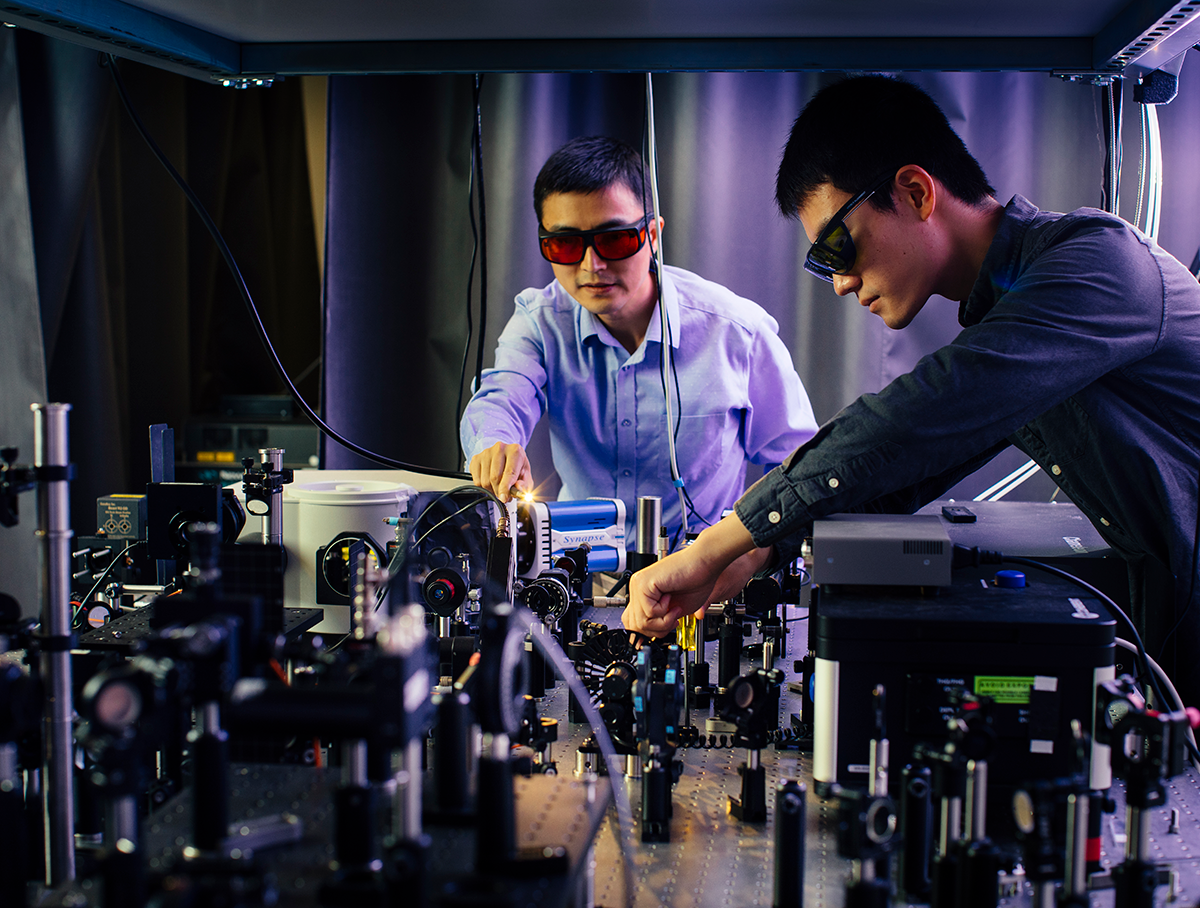Improving the World With Opto-Electronics

If you zoom in close enough to the internal machinery of the computer, tablet or phone that you’re using to read this article, you’ll find crystals. Not sparkly diamonds and emeralds, but miniscule silicon crystals—silicon atoms arranged in a tight, predictable grid that can store and process information within semiconductors.
“Even materials which are not crystals, if you cut them down to small enough pieces, you’ll probably find micro- or nano-crystals inside them,” says Jie Yao, an associate professor of materials science and engineering. “Crystals are quite universal and so understanding them is a very rich field.”
Yao, a 2022 Heising-Simons Faculty Fellow, has made it his mission to not only understand the crystals underlying today’s technology, but develop new types of crystal structures that interact with light and electricity in different and unusual ways. Among his latest projects: crystals that can transmit two wavelengths of light at the same time and crystals that can convert visible light to infrared or ultraviolet and vice versa.
Just as semiconductors revolutionized the production of electronic devices in the last century, Yao thinks these kinds of crystals have the potential to revolutionize optical communication, astrophysics and quantum computing in the years to come.
A desire to change society
In the mid-1990s, Yao was a student in China, beginning his undergraduate education at Nanjing University. At the same time, information technology around the world was experiencing a time of change and growth. For Yao, the emergence of personal computers and a worldwide internet connected him to the broader community of global science, inspired him to cross the Pacific ocean for graduate school at Berkeley, and taught him how basic technologies can impact people’s lives.
“I grew up in this era where we witnessed an incredibly rapid growth of information technology,” says Yao. “My life was substantially improved by these technologies, and it made me want to make my own contributions to the field, so that our lives can all continue to be bettered in that sense.”
At Berkeley, and then during a postdoctoral fellowship at Stanford, Yao studied materials science and engineering. The more he learned about crystal structures, the more he started to believe that new crystals could enable the kind of next-generation, life changing technologies that he had dreamed about being a part of.
Crystals of the future
Crystals, by definition, are materials composed of highly-ordered, repetitive lattices of atoms. This structure means that crystals interact with light and electricity in unique ways that can have powerful technological applications. Optical communication, for instance, is possible because of how tiny crystals can convert light to electronic messages and vice versa.
“I had a very, very slow internet modem in college,” Yao recalls. “I don’t remember the exact transmission rate, but it was probably ten thousand times slower than the internet I’m using right now. And that speed is possible because we’re using optical fibers to transit information.”
Today, information that travels through optical cables is encoded into ultra-fast flashes of light, on and off, on and off. Semiconductor crystals convert those flashes into electronic signals or from electronic signals into light. Optical communication has multiple advantages over the electrical approaches, Yao says. For example, light typically has lower loss than electrical current at high frequencies and is usually immune to electromagnetic interference. The ability to switch between electrical and optical signals has sped up communication and processing speeds. But Yao says optical fibers could become even more powerful with the right new materials.

Yao has discovered a special type of two-dimensional crystals, known as MX materials, that—because of an asymmetric crystal structure—interact with light in different ways depending on the orientation of the material. This means that MX materials can emit two colors of light with different polarizations, giving them more bandwidth than a conventional crystal.
“Currently, with optical communication you can imagine that each channel has one color of light that switches on and off,” says Yao. “If we can encode data in two colors, then that’s at least two channels of information at once, not to mention the polarizations of light.”
A red and a blue channel (by way of example) could transmit more than just a red and a blue; they also could signal a complex signal in between. Light polarized to hit the crystal from one direction would encode a red, from another direction would encode blue, and from any in between would be one of those complex signals. A single flash of light would have far more meaning than on or off.
Twisted Crystals
Like the MX materials, Yao himself is always working on multiple channels of research at once. His lab group is also studying two-dimensional crystals arranged in twisted stacks like a spiral staircase—a field known as twist optics.
“It turns out that this kind of twisting angle gives a material completely different electronic and optical properties,” says Yao.
In the past, researchers have developed these twisted crystals by growing conventional, flat sheets of crystals and then manually stacking them in the right orientations. Yao’s lab group was the first to develop a method to grow the crystals naturally.
“Growing crystals is a bit like growing plants,” he says. “For plants, you provide fertilizer, sunshine and water; for crystals we provide flux of molecules, the right temperature and the right pressure.”
By tweaking that temperature and pressure, Yao discovered that he could force layers of MX materials to grow into a spiral structure that he says looks, under the microscope, like a twisted DNA molecule. The twist introduces new ways for light to interact with the materials—the light can rotate clockwise or counterclockwise depending on the structure. Preliminary evidence from Yao and others shows that twisted materials also can force photons of light to combine or split, an unusual phenomenon that means a material can convert one type of light (visible, ultraviolet or infrared, for instance) to another or generate completely new colors.

With his Heising-Simons award, Yao plans to better characterize how these twisted crystals interact with light and probe whether other twisted crystals (so far he’s only made them in one variety of MX) have the same properties.
“We’re opening up an entirely new research direction,” he says.
Only time will tell whether Yao’s crystals will be the semiconductors of tomorrow, reshaping the world’s economies and connecting people and information in new ways. For now, Yao remains excited and driven forward by the possibility.
Jie Yao is a Heising-Simons Faculty Fellow. To learn more about the program, please visit: https://vcresearch.
